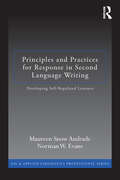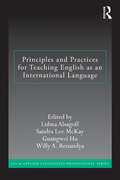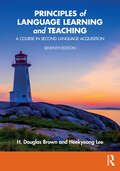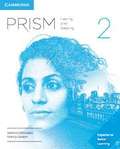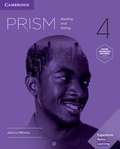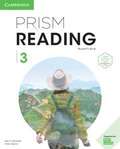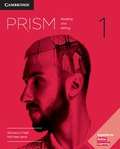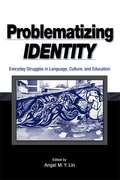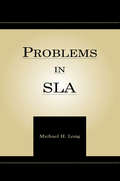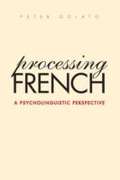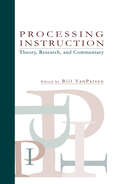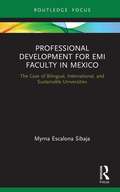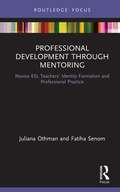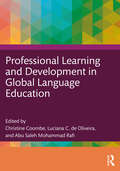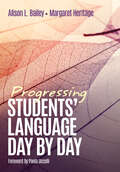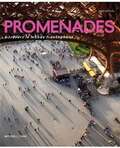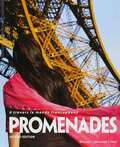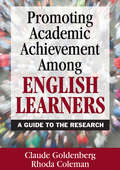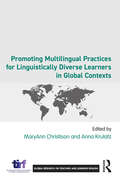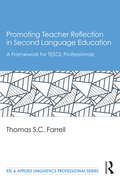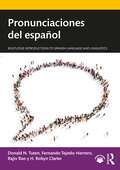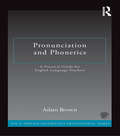- Table View
- List View
Principles and Practices for Response in Second Language Writing: Developing Self-Regulated Learners (ESL & Applied Linguistics Professional Series)
by Maureen Snow Andrade Norman W. EvansBased on the assumptions that students expect feedback and want to improve, and that improvement is possible, this book introduces a framework that applies the theory of self-regulated learning to guide second language writing teachers’ response to learners at all stages of the writing process. This approach provides teachers with principles and activities for helping students to take more responsibility for their own learning. By using self-regulated learning strategies, students can increase their independence from the teacher, improve their writing skills, and continue to make progress once the course ends, with or without teacher guidance. The book focuses on the six dimensions of self-regulated learning —motive, methods of learning, time, physical environment, social environment, and performance. Each chapter offers practical activities and suggestions for implementing the principles and guidelines, including tools and materials that teachers can immediately use.
Principles and Practices for Teaching English as an International Language (ESL & Applied Linguistics Professional Series)
by Lubna Alsagoff Willy A. Renandya Guangwei Hu Sandra Lee McKayWhat general principles should inform a socioculturally sensitive pedagogy for teaching English as an International Language and what practices would be consistent with these principles? This text explores the pedagogical implications of the continuing spread of English and its role as an international language, highlighting the importance of socially sensitive pedagogy in contexts outside inner circle English-speaking countries. It provides comprehensive coverage of topics traditionally included in second language methodology courses (such as the teaching of oral skills and grammar), as well as newer fields (such as corpora in language teaching and multimodality); features balanced treatment of theory and practice; and encourages teachers to apply the pedagogical practices to their own classrooms and to reflect on the effects of such practices. Designed for pre-service and in-service teachers of English around the world, Principles and Practices for Teaching English as an International Language fills a critical need in the field.
Principles of Language Learning and Teaching: A Course in Second Language Acquisition
by H. Douglas Brown Heekyeong LeeThe seventh edition of this classic second language acquisition (SLA) text provides an overview of the theoretical foundations of language teaching. This new edition has been updated to capture current research and practice in the field. Among concepts that are either redefined or entirely new are: Language learning in an era of globalization and multilingualism The significance of transnationalism, identity, investment, agency, and ideology Language learning as situated, usage-based, and socioculturally contextualized The importance of emotional engagement, intercultural sensitivity, and self-efficacy in language learning Transdisciplinary and ecological approaches as keys to language teaching in the 21st century The seventh edition also retains useful historical information and foundational cornerstones of SLA that teachers have found beneficial in their instruction. Key principles continue to be presented and explained with direct application to classroom language education and real-life contexts. Features such as "Points to Ponder" (questions for readers’ personal reflection), classroom connections and "Tips for Teaching," suggested readings, and a glossary of terminology are updated in this edition. With its reader-friendly style, practical pedagogical tools, and comprehensive coverage of state-of-the-art research findings, this edition serves as an essential resource for language teacher education programs worldwide, catering to the needs of both novice and experienced language teachers.
Prism Level 2: Listening and Speaking
by Angela Blackwell Sabina Ostrowska Nancy Jordan Janet GokayPaired skills course focusing on critical thinking, academic skills, and language students need most. Prism is a five-level (A1 to C1), American English paired-skills course (Reading/Writing and Listening/Speaking), created for students who need to develop a range of academic skills. This Level 2 (B1) Listening and Speaking Student's Book prepares students for college classes by developing their listening, speaking, critical thinking, and pronunciation skills, including pronunciation for listening. Special sections teach how to be a successful college student, and the accompanying video program sets the stage for each unit's topic. Inside the book is a single-use code for the online workbook. This provides automatically graded extra practice and works on PCs and Macs.
Prism Level 4 Student's Book With Online Workbook Reading And Writing (Prism)
by Jessica Williams Wendy Asplin Christina CavagePaired skills course focusing on critical thinking, academic skills, and language students need most. Prism is a five-level (A1 to C1), American English paired-skills course (Reading/Writing and Listening/Speaking), created for students who need to develop a range of academic skills. This Level 4 (C1) Reading and Writing Student’s Book prepares students for college classes by developing their critical thinking, reading and writing skills, including grammar for writing. Special sections teach how to be a successful college student, and the accompanying video
Prism Reading Level 3 Student's Book With Online Workbook
by Alan S. Kennedy Chris SowtonPrism Reading Level 3 has 8 units to develop vocabulary, academic, and critical thinking skills. Students experience topics through fascinating readings in a wide variety of genres and formats to become familiar with material they might face in or outside the college classroom. Each book includes a single-use code to access the Online Workbook that has one new reading per unit, extra practice to further improve reading, vocabulary, and language development. Other resources include videos and recordings of readings. Activities have automated feedback to help with learner autonomy, and for teachers to spend less time grading and more time teaching.
Prism: Level 1 Student's Book With Online Workbook Reading And Writing (Prism)
by Wendy Asplin Carolyn Flores Richard O'Neill Michele LewisPrism Level 1 Student's Book Reading and Writing 9
Problematizing Identity: Everyday Struggles in Language, Culture, and Education
by Angel M. Y. LinThis book argues that identity as a term needs to be problematized, not taken for granted � for both the risks and the potential that the concept offers to educators for understanding issues of social inequality and how social inequality is being reproduced, and for exploring possible alternative ways educators can work with identity de/formation p
Problems in Second Language Acquisition (Second Language Acquisition Research Series)
by Michael H. LongSecond language acquisition has an identity problem. It is a young field struggling to emerge from the parent fields of education and applied linguistics. In his new book, Problems in Second Language Acquisition, Mike Long proposes a way to help second language acquisition develop a systematic and coherent focus using the philosophy of science as the lens.The volume is neatly organized into three parts--theory, research, and practice. This structure allows a focus on areas of SLA of interest to many in the field. These include theory proliferation and comparative theory evaluation; the Critical Period Hypothesis and negative feedback; and the practice of “synthetic” language teaching.The controversial volume will be of interest to researchers, educators, and graduate students in second language acquisition, applied linguistics, TESOL, and linguistics programs. It may be recommended as additional reading for an introductory SLA course in order to stimulate class discussions.
Processing French: A Psycholinguistic Perspective
by Peter GolatoProcessing French presents a groundbreaking empirical study of the processing of morphologically simple and complex French words. Peter Golato's research offers an insightful account of the lexical storage and retrieval of isolated words and words within sentences. Processing Frenchinvestigates the native-language processing of French, a language for which findings have not definitively supported a dual-mechanism account of morphological processing. Through word- and sentence-level studies, the book accomplishes two goals. First, it offers behavioral evidence in support of a dual-mechanism processing account at the word level. In contrast to English, however, the evidence with French does not turn upon a contrast in inflectional regularity among verbs but instead hinges upon a diachronic contrast, with synchronic relevance, in the productivity of derivational suffixes among nouns. Second, by incorporating the findings of the word-level studies into sentence-level studies, the book offers a window onto the morphological processing of displaced sentential elements, specifically morphologically simple and complex-moved nouns and raised lexical verbs. Peter Golato is assistant professor of French at the University of Illinois at Urbana-Champaign. "Processing French is decidedly original, and it is equally and decidedly sound. This book makes a superb shelf reference for anybody working in psycholinguistics, first- and second-language acquisition, and the syntactic study of French. . . and draws some fascinating conclusions about what might really be at play in human language acquisition. " -Fred Davidson, University of Illinois at Urbana-Champaign
Processing Instruction: Theory, Research, and Commentary (Second Language Acquisition Research Series)
by Bill VanPattenThis new book, Processing Instruction: Theory, Research, and Commentary, edited by Bill VanPatten--a pioneer in processing instruction (PI)--is a refreshing presentation of 10 related and not widely available articles that illustrate the role of processing instruction in second language acquisition. The articles provide both historical and current context, as well as describe the influence of the input processing model on PI. The contents include empirical papers presenting new data that demonstrate both the theoretical and pedagogical threads of research. Aside from simply establishing where PI stands in the field of instructed SLA, the book addresses issues, such as processing instruction versus other types of instruction; the impact of processing instruction on various linguistic structures; the role of explicit information in instructional intervention; and the long-term effects of processing instruction. Each section of the book is highlighted by commentaries from noted researchers in instructed SLA. An attempt was made to include voices that offer critical perspectives on various issues of PI research. The book achieves an unusually balanced approach to a subject that has stirred debate in the field. Processing Instruction: Theory, Research, and Commentary will serve as an important source of information regarding research methodology and replication in second language acquisition. It will also be useful in graduate courses where students need exposure to research design and is especially useful for illustrating the usefulness of replication in SLA research.
Professional Development for EMI Faculty in Mexico: The Case of Bilingual, International, and Sustainable Universities (Routledge Focus on English Medium Instruction in Higher Education)
by Myrna Escalona SibajaDespite Mexico’s implementation of a bilingual model in its tertiary education programmes, this book is the first contribution to knowledge regarding EMI in Mexico. The author introduces readers to the Mexican higher education context before providing detailed information regarding the technological and polytechnic subsystem, where EMI has been implemented since 2012. The volume details a pilot and case study conducted in Mexican universities as well as the research findings and conclusions. It closes with recommendations, as well as suggestions for further research. The book explores the implications for the continuous professional development and training for lecturers in the current shift to EMI in Bilingual, International, and Sustainable (BIS) universities. This volume will be of particular interest to researchers in EMI and bilingualism.
Professional Development through Mentoring: Novice ESL Teachers' Identity Formation and Professional Practice (Routledge Research in Teacher Education)
by Juliana Othman Fatiha SenomIn their book, Othman and Senom provide a unique insight into the challenges faced by novice English as a Second Language (ESL) teachers and establish how mentoring can provide effective support for new teachers’ professional development. The book demonstrates the theoretical background for viewing mentoring as a process crucial to novice teachers’ development, particularly to the teachers’ ability to succeed and grow in a specific workplace environment. Using case studies from a Malaysian context, this book provides a comprehensive understanding of how mentoring can serve as a strategy to facilitate the transition of novice ESL teachers from a teacher education programme to life in real classrooms. Through its case studies, the book will examine both theoretical and practical issues for mentors, teacher educators, policymakers, and administrators when mentoring new ESL teachers. This book will be valuable to researchers who are particularly interested in exploring novice teachers’ identity development, and experienced teachers to help guide new teachers through the socialization process in their schools.
Professional Learning and Development in Global Language Education
by Luciana C. Oliveira Christine Coombe Abu Saleh Mohammad RafiThis edited collection focuses on general principles and practices of professional learning and development in both pre-service and in-service teacher contexts for language education around the world.The field of teaching is a constantly evolving profession, and one of the most important aspects of teaching is learning. Research shows that the more professional learning and development that teachers engage in, the more likely their students are to succeed and the more likely they are to be effective and fulfilled in their careers. This edited collection seeks to stress the continued importance of teacher engagement in professional learning and development for language educators through a variety of different essential elements, among them pre-service teacher education, in-service teacher education, utilizing professional associations, as well as technology-enhanced activities. The book showcases the diversity of teacher learning and development activities and practices used in unique and atypical language education contexts around the world. The contributions in this collection exhibit work done on the African continent and in countries such as Brazil, Canada, Japan, Nepal, Saudi Arabia, the United Arab Emirates, the United States, and the United Kingdom.The book will be especially useful for students and pre-service teachers in TESOL, language teaching, and bilingual education, as well as in-service teachers of multilingual learners.
Progressing Students′ Language Day by Day
by Margaret Heritage Alison L. BaileyBecause content and language learning go hand in hand New content standards integrate content and language in ways prior standards have never done. That’s why it’s so critically important that teachers attend to both content and language development when introducing new subject matter, especially for English learners. Here’s your opportunity to get started tomorrow and every day thereafter: Alison Bailey and Margaret Heritage’s all-new Progressing Students’ Language Day by Day. What’s so utterly ground-breaking about this book is Bailey and Heritage’s Dynamic Language Learning Progression (DLLP) process: research-based tools for obtaining much deeper insight into a student’s language progress, then for identifying the most appropriate instructional steps to elevate language proficiency and content knowledge. Step by step, Bailey and Heritage describe how to Engage with students to advance their development of sophisticated, high-leverage language features for explaining content Use the DLLP approach to formative assessment, then plan your teaching in response to assessment evidence Examine words, sentences, and discourse --the three dimensions of language that are part of the DLLP process for cultivating language development Discover how leadership support and communities of practice (CoPs) can facilitate a successful and sustainable implementation of the DLLP process Listen more closely and uncover new ways to advance content learning with Progressing Students’ Language Day by Day directly by your side. "Alison Bailey and Margaret Heritage open our eyes to the often invisible and context-specific language demands embedded in content learning. Understanding the ubiq¬uitous and highly influential role of language in learning takes time and effort but leads to transformative practice. Progressing Students’ Language Learning Day by Day offers an insightful and concrete framework to begin this transformation." — Paola Uccelli, Professor of Education, Harvard University
Progressing Students′ Language Day by Day
by Margaret Heritage Alison L. BaileyBecause content and language learning go hand in hand New content standards integrate content and language in ways prior standards have never done. That’s why it’s so critically important that teachers attend to both content and language development when introducing new subject matter, especially for English learners. Here’s your opportunity to get started tomorrow and every day thereafter: Alison Bailey and Margaret Heritage’s all-new Progressing Students’ Language Day by Day. What’s so utterly ground-breaking about this book is Bailey and Heritage’s Dynamic Language Learning Progression (DLLP) process: research-based tools for obtaining much deeper insight into a student’s language progress, then for identifying the most appropriate instructional steps to elevate language proficiency and content knowledge. Step by step, Bailey and Heritage describe how to Engage with students to advance their development of sophisticated, high-leverage language features for explaining content Use the DLLP approach to formative assessment, then plan your teaching in response to assessment evidence Examine words, sentences, and discourse --the three dimensions of language that are part of the DLLP process for cultivating language development Discover how leadership support and communities of practice (CoPs) can facilitate a successful and sustainable implementation of the DLLP process Listen more closely and uncover new ways to advance content learning with Progressing Students’ Language Day by Day directly by your side. "Alison Bailey and Margaret Heritage open our eyes to the often invisible and context-specific language demands embedded in content learning. Understanding the ubiq¬uitous and highly influential role of language in learning takes time and effort but leads to transformative practice. Progressing Students’ Language Learning Day by Day offers an insightful and concrete framework to begin this transformation." — Paola Uccelli, Professor of Education, Harvard University
Promenades: A Travers Le Monde Francophone
by James G. MitchellWelcome to PROMENADES, Third Edition, a unique introductory French program from Vista Higher Learning. In French, the word promenades means strolls. The major strands in PROMENADES, Second Edition, are strolls planned to help you learn French and explore the cultures of the French-speaking world in the most user-friendly way possible. In light of this goal, here are some of the features you will encounter in PROMENADES, Third Edition.
Promenades: A Travers le Monde Francophone
by Cherie Mitschke Cheryl Tano James G. MitchellWelcome to PROMENADES, Second Edition, a unique introductory French program from Vista Higher Learning. In French, the word promenades means strolls. The major strands in PROMENADES, Second Edition, are strolls planned to help you learn French and explore the cultures of the French-speaking world in the most user-friendly way possible. In light of this goal, here are some of the fea¬tures you will encounter in PROMENADES, Second Edition.
Promenades: À travers le monde francophone
by Cherie Mitschke Cheryl TanoPromenades, 2nd Edition, focuses on building those skills introductory students need to feel confident while immersing themselves in authentic French culture.
Promoting Academic Achievement Among English Learners: A Guide to the Research
by Claude Goldenberg Rhoda ColemanDiscover the research and facts on what works in educating English learners! This comprehensive resource examines the research on promoting success among students who come to school knowing little or no English and translates current findings into specific recommendations for developing policies and programs for English learners. With illustrative scenarios throughout, this book gives educators and policy makers solid, research-based information about: Using students’ home language in academic programming Teaching English and academic content simultaneously School and district factors that affect achievement for English learners Sociocultural factors in success, including the influence of parents and families
Promoting Multilingual Practices for Linguistically Diverse Learners in Global Contexts (Global Research on Teaching and Learning English)
by Anna KrulatzThe eleventh volume in the Routledge-TIRF series presents research on multilingualism in educational contexts across the globe. With chapters written by TIRF Doctoral Dissertation Grant awardees and internationally known scholars, the volume addresses the challenges and pedagogies associated with moving away from the monolingual paradigm to support the development of culturally and linguistically diverse learners. Offering original research, new models, and pedagogies on teaching from over 17 different countries, this volume familiarizes readers with the latest advances in theory and practice and is a key text for language education programs and pre-service teachers.
Promoting Teacher Reflection in Second Language Education: A Framework for TESOL Professionals (ESL & Applied Linguistics Professional Series)
by Thomas S. FarrellTaking the concept and the practice of reflective teaching forward, this book introduces a well-structured, flexible framework for use by teachers at all levels of development, from pre-service to novice to the most experienced. The framework outlines five levels of reflective practice—Philosophy; Principles; Theory-of-Practice; Practice; Beyond Practice—and provides specific techniques for teachers to implement each level of reflection in their work. Designed to allow readers to take either a deductive approach, moving from theory-into-practice, or an inductive approach where they start from a practice-into-theory position, the framework can be used by teachers alone, in pairs, or in a group.
Pronunciaciones del español
by Rajiv Rao Fernando Tejedo-Herrero Donald N. Tuten H. Robyn ClarkePronunciaciones del español es una introducción accesible a la fonética y la fonología del español que destaca la diversidad de pronunciaciones empleadas en el mundo hispanohablante. Con explicaciones claras y gráficos detallados, este libro guía al estudiante en el aprendizaje de conceptos claves de fonética articulatoria y acústica. El libro presta especial atención a la variación sociolingüística, a partir de ejemplos que cubren pronunciaciones típicas de variedades estándares y de variedades generalmente consideradas no normativas. Una abundante selección de ejercicios y actividades permite al estudiante reforzar la comprensión de conceptos claves y practicar las pronunciaciones comentadas. Un glosario bilingüe (español-inglés), archivos de audio y recursos pedagógicos se encuentran disponibles en línea en www.routledge.com/9781138657540. El libro es idóneo para estudiantes que inician estudios al nivel avanzado de español y de lingüística hispánica y que buscan familiarizarse con las pronunciaciones de diferentes variedades de español. Pronunciaciones del español is an accessible introduction to the linguistic diversity of Spanish phonetics and phonology. With clear explanations and detailed illustrations, this book guides students through key concepts in articulatory and acoustic phonetics. Particular attention is paid throughout to sociolinguistic variation, with examples covering pronunciations typical of standard varieties as well as varieties generally considered to be non-normative. A rich array of exercises and activities allow students to reinforce understanding of key concepts and practice the pronunciations as described. A bilingual glossary, accompanying audio files and teaching resources are available online at www.routledge.com/9781138657540. This book is ideal for advanced students of Spanish and Hispanic Linguistics, looking to develop familiarity with the pronunciation of different varieties of Spanish.
Pronunciation and Phonetics: A Practical Guide for English Language Teachers (ESL & Applied Linguistics Professional Series)
by Adam BrownThis engaging, succinct text is an introduction to both phonetics and phonology as applied to the teaching of pronunciation to English language learners. Section 1 selectively covers the main areas of phonetics and phonology, without going into any area in more depth than the average English language teacher requires or that the average English language teacher trainee can handle. Section 2 focuses on practical issues related to learners and how they learn languages, and what represents good practice in terms of classroom activities for pronunciation—including aspects such as targets, motivation and priorities. The chapters end with activities to help the reader understand concepts. Section 3 provides innovative sample activities which put into practice the theoretical points covered in the first two sections, answers to the various exercises, recommended further reading (both print and non-print), a glossary of technical phonetic terms, and a bibliography of works on pronunciation teaching. The text is accompanied by a Companion Website with audio recordings of model pronunciations and audio material relating to the activities.
